Knowing How To Fish Plastic Worms
A Bass Angler’s Most Fundamental Skill for Catching Bass
If you're after big bass, or just bass, plastic worms are probably the best bass lure you could use. Something about their long, thin bodies and their action in the water, at least at the hands of a skilled angler, attracts bass to what resembles many of their natural prey.
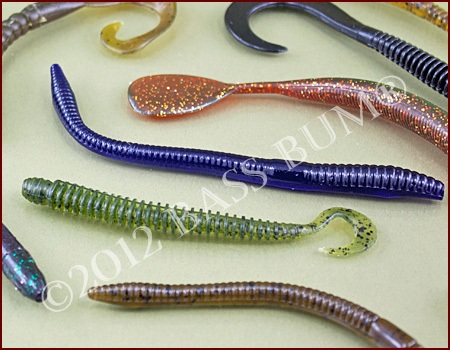
Plastic worms are eye contact lures so produce better in clear or stained water. Some anglers have taken up the habit of inserting small rattles in their worms in order to, hopefully, appeal to the hearing and lateral line of bass as well as its sight. I haven't tried that yet but being the junk fisherman I am no doubt I will.
Basic styles are straight, curly tail, paddle tail, ribbed, finesse, floating and flipping. How do you fish for bass with plastic worms? There are numerous "techniques" and "rigs" for worms. The number of hook styles for worms aims at meeting every conceivable application and condition. Oh, and colors, there are more available than are even found in nature.

There Is No Single Formula For Choosing A Specific Plastic
Worm For A Given Situation, However...
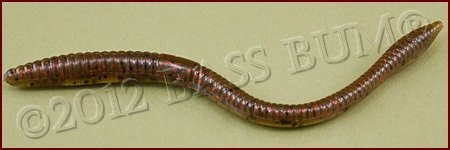
Straight worms have little "built in" action and depend on the angler to work action into the presentation. Nevertheless, they appeal to active and inactive bass, especially a 6" version.
They tend to fall quickly compared to other worms and with a bit of a darting action while falling. "Drop speed" or "fall rate" of a worm is important because bass tend to strike lures "on the fall". Note that aggressive bass will be more likely to attack a fast dropping worm but inactive bass will prefer a slow drop.
If you're not "bit" on the initial fall you are then on the bottom and can choose to either "deadstick" it or "lift-drop" it back to the boat.
Straight tail plastic worms move better through cover than worms with curly or ribbon tails which tend to get wrapped on branches or weed stems.
Personally, I feel the best hook style for a 6" straight tail worm is a straight shank hook. A straight shank hook has a smaller pull angle from the line to the hook point enabling a better hook set. However, the worm will often slide down the hook shaft when setting the hook. Some feel this allows the hook to more easily penetrate the plastic when Texas rigged, others feel it's just a pain in the butt.
Fewer bass are lost, at least by me, with straight shank, round bend worm hooks. A size 2/0 or 3/0 hook size is a good choice for a 6" plastic worm. There are many anglers, however, who prefer offset hooks and even wide gap hooks for their plastic worms.
Straight tail worms are the style most often fished as "floating" worms in the spring. A great technique for bass big and small.

Curly Tail worms exhibit more action from their tails as a curly tail grabs more water slowing the lures fall. This slower fall and tail action attracts puts out a little more vibration and is more likely to visually attract active and moderately active bass. Remember, bass are primarily sight feeders and worms as a rule make no significant sound. You must present the worm so it is seen for it to be eaten.
They are sometimes fished on light round or mushroom style jig heads in grass and weeds. I also fish them on split-shot rigs. I always use spinning gear for this style worm if it's less than 6" long. My rod choice is usually a medium fast action with a a 2500 size spinning reel.

Stickworms, sometimes called "stickbaits", and I'm referring here specifically to the Senko style and not Slug-Gos or Flukes, tend to be fat and tapered on both ends. They are also more dense than most other plastic worms and fall more slowly as they encounter more water resistance.
These are great fished purely weightless or wacky rigged where they fall horizontally, unlike most other plastic worms. The two ends tend to undulate during the slow fall and this action is very appealing to bass.
This worm can be very effective in pre and post spawn weeds but also during the fall of the year. I've had good success fishing them on bluffs wacky style by casting up close to the bluff and letting them drift slowly down its face.
You will want to use a medium to medium heavy rod 6´ to 6´ 6" in length with this lure. I use both spinning and bait casting rigs for this. As for line, I like monofilament rated 10-12lbs. Hook size depends on the length of the lure and how you're rigging it. If rigging a 5" straight and weightless I use a wide gap 3/0 and for a 4" a 2/0 wide gap hook.
The key to success with stickworms is to fish them SLOW.

Ribbed and Ringed Worms are most often curly tails or even ribbon tails with a ribbed body. The theory is that as it is retrieved the many ribs in the body move more water and thereby create more waves from water displacement. The bass is then alerted to this movement via its lateral line and moves to the worm striking it. I'm not sure about that, but I do know that ribbed worms are very soft and quite likely cause the bass to hold on a bit longer, at least in my experience.
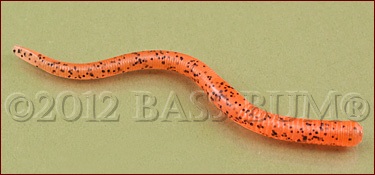
Finesse Worms are smaller in length and bulk and target lure weary, inactive, obstinate bass. The techniques most often employed with finesse worms are the drop-shot and split-shot techniques using worms no longer than 4".
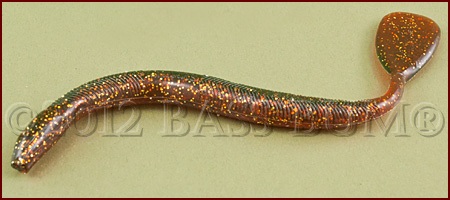
Paddle Tail worms are often bulkier overall and this feature combined with the paddle tail displaces more water generating water disturbance. It is felt that the resulting waves are detected by bass. Thus, this style worm is considered a good plastic worm for fishing water with low visibility or in thick cover.
Some anglers will fish these style worms as you would a topwater lure and claim vicious strikes.
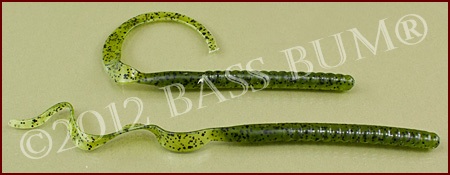
Ribbon or Gator Tail Worms 10-11" long are one style I use in summer. They are thicker and longer and fill the bill when bass are looking for larger prey later in the season.
In clear or stained water they are easily seen by bass. They work very well in weeds or grass as well as in low light conditions such as overcast, rainy days and at night. They are not the best for thick brush as they will without question get hung up and become a source of frustration to you.
My tackle for fishing these larger worms includes a medium heavy rod, a medium size baitcasting reel and 12-20lb test monofilament line. You will undoubtedly decide on what combination best fits your fishing style.

Hook Choice For Worms
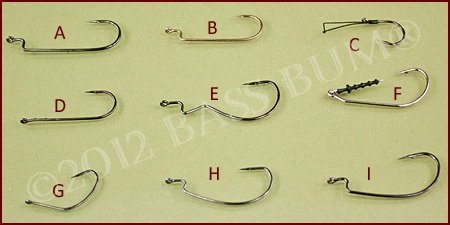
Hook Choice for worms falls generally within sizes 1 to 5/0. There are many worm styles but those at right are a few I use.
A and B. Offset Straight Shank hooks allow for rigging a worm very straight thereby minimizing line twist.
C. Weedless Finesse hooks are what I use when fishing wacky style in cover.
D. Straight Shank hooks enable better hook sets, according to some, because they provide a smaller pull angle from the line tie to the hook point.
E. "Skip Gap" style hooks are excellent for "skipping" stick worms rigged weightless under docks or other overhead cover.
F. Baitgripper style hook. I sometimes use this on thicker, solid headed worms and other plastic baits.
G. Shiner Hooks are what I use for wacky rigging "stickbaits".
H. Light Wire Wide Gap hooks are good for thicker worms and they seem to penetrate the fish's jaw better than heavy wire hooks.
I. Heavy Wire Wide Gap hooks are the same as light wire but gives me more confidence when anticipating larger bass.

Return to Bass Fishing Lures from Plastic Worms
